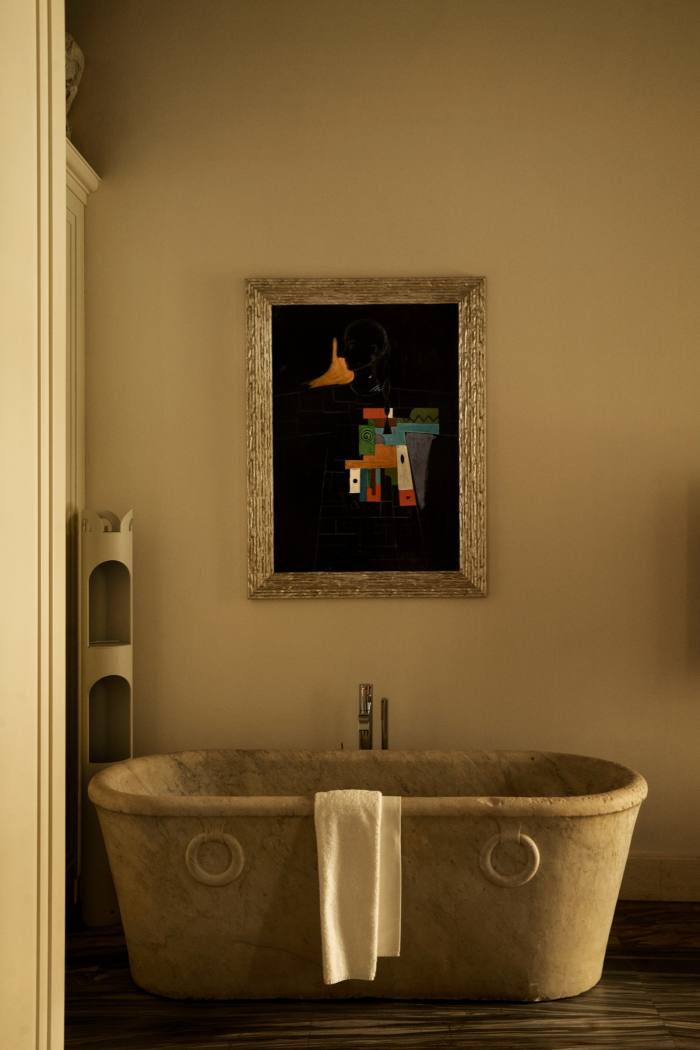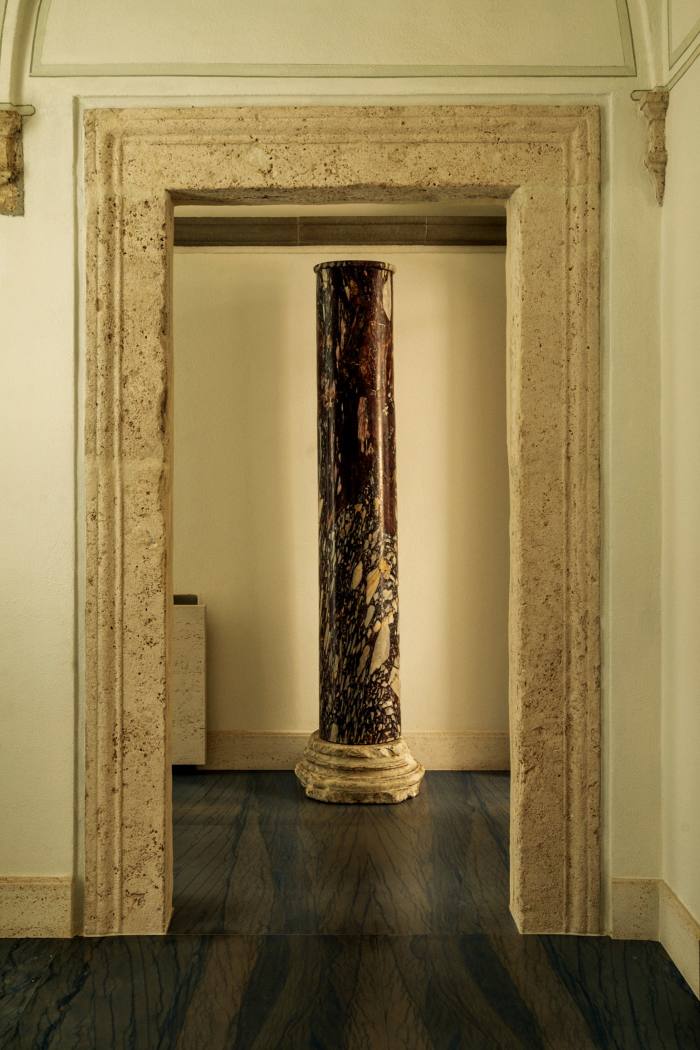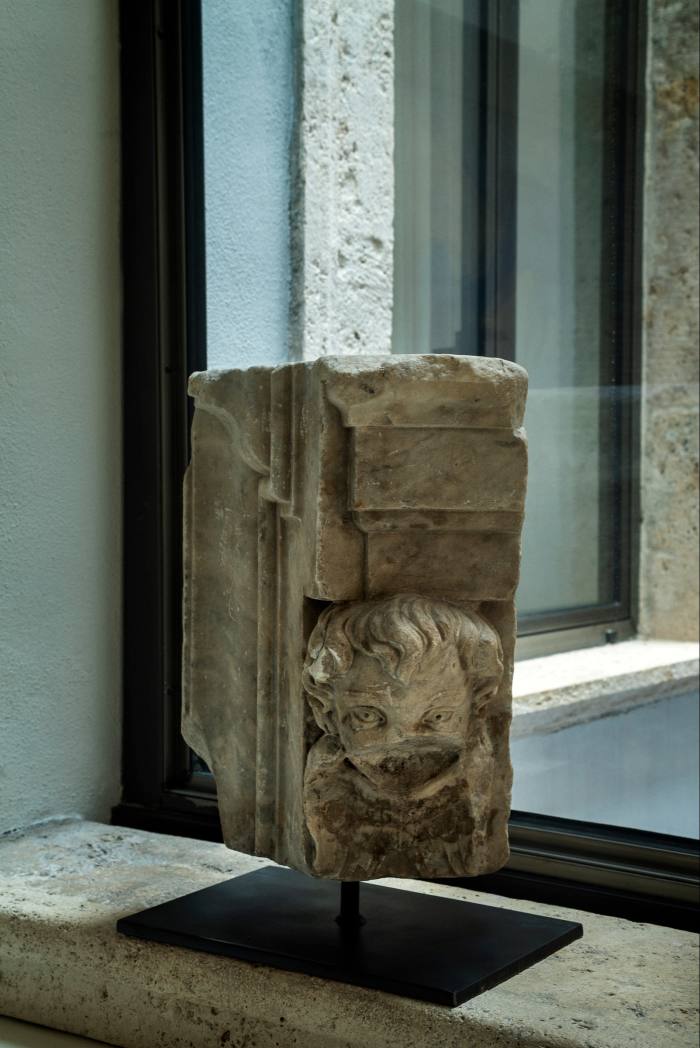Delle Pietre, a perfect palace in the heart of Rome
Every building in the old center of Rome tells a story – and chances are it’s longer and more interesting than you think. The six-story building at Via delle Coppelle 23 is no different. Its medieval foundations rest on the ruins of the Terme Alessandrine, a thermal complex built by Nero around 62 AD and allegedly still in use in the 5th century AD. In the 15th century the building had been expropriated by the Vatican to serve as a charitable arm, which it did until the 19th century. It then changed hands a few times before emerging after the war as an apartment building, more or less as anonymous as any surrounding it.
The entrance to the Palazzo delle Pietre on Via delle Coppelle © Antonio Monfreda

A Roman column reused in a living room © Antonio Monfreda
In 2009, when Carlo Mazzi first saw it, there were over 13 owners and a lot of infighting, “like a bad telenovela,” he says. But that didn’t stop him, his wife Patrizia Albano and his daughter Barbara Mazzi Pensieroso from pursuing their acquisition plans. Three years later, the Mazzis had convinced each of them to sell. Former president of Prada SpA and member of the board of directors of several banks and financial institutions, a graduate in engineering and economics, Mazzi is also a renowned collector, with a weakness for beauty and antiquity. Beneath the palace’s recent history, it saw the outlines of a new purpose – a building that would celebrate each era of its existence for those seeking a rarer variety of Roman hospitality.
This is how Palazzo delle Pietre – the new name of Via delle Coppelle 23 – was born in its current form. With eight apartments (the largest can comfortably sleep up to five people), the Palazzo is a supremely stylish approach to long or short stays in town. The decor, which brings together museum-quality Roman antiquities, Renaissance and Baroque furniture, collectible textiles, rare marbles and original contemporary art, is a showcase for both Italian history and the eye. warned of Mazzi for a good piece – high or low provenance. Mazzi hopes the Palazzo delle Pietre will soon become a center for cultural exchange, via FraMmenti Club, a cultural organization in which his wife is involved – a place to discuss and celebrate history, food and wine, music and architectureand how they connect in contemporary society.

A marble bathtub from the Napoleonic era © Antonio Monfreda

Old poplar doors in travertine marble frames © Antonio Monfreda
In Rome, as elsewhere, the model of luxury self-catering takes different forms, from Airbnb Plus (where you mostly pay for high-end design) to Rocco Forte House, whose five very stylish but fairly uniform apartments near Piazza di Spagna come with daily service and stocked pantries. At the Palazzo delle Pietre, the offering is top-notch service – not just pantry stocking and daily housekeeping, but also a private guide, wine tasting, art and treasure hunt. antiques; all, of course, without the ambiance of a “serviced” environment. This last part is helped considerably by the fact that the Mazzi themselves have a stake in things: they live in the top-floor apartments.
In Rome, a good home is discreet – I walk past the door twice before realizing it’s the entrance. Once inside, I’m struck by the quiet: the walls almost completely block out the humming chaos Vespas and horns on the street outside (among the Palazzo’s compelling attributes is its ultra-central location, between Piazza Navona and the Pantheon).

The headboards were carved by a craftsman from Arezzo © Antonio Monfreda

A travertine doorway from the 15th century building frames a 2nd century breccia column © Antonio Monfreda
Mazzi, dapper in a powder blue sports jacket with leonine silver hair, shows me around the ground floor rooms, to which guests have full access. Many of them are covered in an extraordinary marble resembling Madagascar labradorite which, roughly speaking, resembles a frozen glacial lake, the tones changing dramatically from duck egg white to near cobalt. The effect is glamorous and contemporary. Mazzi used all the marbles in the palace – and there are at least 10 of them, each one more beautiful and richer in tone than the other – as they would have been in antiquity: from afar (the Romans plundered the their dues on the borders of the empire), chosen for the audacity of their colors and deployed generously.
The floor contrasts sharply with the deep russet stone of an antique column on display in one room and rings nicely with two 19th century benches painted a richer blue. In an adjacent salon, contemporary De Padova chairs surround a 2nd-century Corinthian chapter that has been repurposed as a coffee table. The sun pours through the ceiling of the veranda, highlighting the incisions on a wall fragment of a Roman entablature.
This refined collision of eras is reiterated throughout the building, much of the design conceived by Mazzi in collaboration with Maurizio Pappalardo of mp2a Architetti Associati. The process took nearly seven years, with daunting structural intervention (as is often the case, once the work began, it became clear that the scope was far greater than anyone had anticipated). But the end result is a series of spaces that exalt a whole range of good patternwhether they are two years old or two millennia old.

The Renaissance courtyard fountain © Antonio Monfreda

A Calacatta marble bathtub sits in a niche of the 15th century structure © Antonio Monfreda
The first-floor apartments feature loft-style layouts, with bedrooms set under wood-beamed ceilings covered in ornate 18th-century paintings. In the other seven, the aesthetic is eclectic. Large Caucasian tapestries by famed Milanese dealer Altai Gallery hang on the walls (and rugs largely from Africa rest on even more striking marble floors). Alivar and Kartell chairs and ottomans are scattered around a discreetly placed flat-screen TV.
But the centerpieces are the artifacts, architectural remnants, textiles, and art in each space — most owned by Mazzi, but some original to the building — and the skill with which they are mixed together. In one bedroom, a wooden door frame is painted with an ornate pattern of apricot yellow marble. “It had to be discarded at some point,” says Mazzi. “It was covered in layers of varnish, dark brown. Then we thought, ‘Can we send it to our restorers [Mazzi works regularly with such artisans in Tuscany]?’ They started devarnishing and found this incredible marmorized pattern below. In another bedroom, an alcove at the top of the wall houses a collection of terracotta cylinders: simple but beautiful serving objects that play like a sculptural installation in the space. Funeral ? I ask. “No, these are vessels that were used to collect water from roofs, originally they fitted into each other. In fact, we found them here.
Mazzi turns the Rivolta Carmignani sheets over the bed to show me a piece of which he is particularly proud: a headboard he fashioned from the two wings of a 16th century choir chair. An inspired repurposing, which in turn inspired similarly themed rooms, including the charming ground floor apartment’s headboard, made from two painted 17th-century candle bases, originally intended for a cathedral and reworked by a craftsman from Arezzo.

Restored 19th century desk with a pair of Italian porcelain vases © Antonio Monfreda

Fragment of a Renaissance marble portal representing the head of a young boy © Antonio Monfreda
And so on, over six floors and tens of centuries: a pre-Christian inlaid marble plinth or table here, an enormous 19th-century suzani there. Hanging over a doorway is an ornately carved 17th-century wooden frieze, restored to Mazzi’s specifications by a famous Arezzo bottega; in the private garden of the ground floor apartment, a monumental marble fountain from the High Renaissance. Hand polished brass kitchen cabinets; an original Warhol Flowers silkscreen above a bed.
The Palazzo’s underground rooms have also been put to good use, with a compact fitness center stocked with Technogym and a unique but very luxurious spa treatment suite – again clad in marble, this one a brown on silver with large veins. We end our morning in the dining room on the ground floor, discussing the FraMmenti Club, which was activated last year, with musical performances, lectures by antique dealers and historians, etc., which are held monthly for its members (Palazzo guests who speak Italian, he says, are always welcome). In the meantime, he is preparing a compendium on the Palazzo itself – the history and provenance of its treasures – to experience in each apartment for his guests, a project he is clearly enthusiastic about. It will, he hopes, be a catalyst for enjoying the palate the way he does; a guide to all the unexpected stories behind the facade.
palazzodellepietre.com; from €600 per night for a minimum stay of two days


Comments are closed.